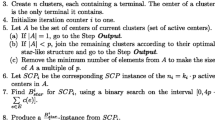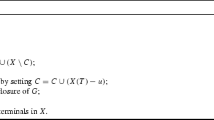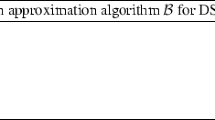Abstract
Directed Steiner Tree (DST) is a central problem in combinatorial optimization and theoretical computer science: Given a directed graph \(G=(V, E)\) with edge costs \(c \in {\mathbb {R}}_{\ge 0}^E\), a root \(r \in V\) and k terminals \(K\subseteq V\), we need to output the minimum-cost arborescence in G that contains an \(r \rightarrow t\) path for every \(t \in K\). Recently, Grandoni, Laekhanukit and Li, and independently Ghuge and Nagarajan, gave quasi-polynomial time \(O(\log ^2k/\log \log k)\)-approximation Algorithms for the problem, which are tight under popular complexity assumptions. In this paper, we consider the more general Degree-Bounded Directed Steiner Tree (DB-DST) problem, where we are additionally given a degree bound \(d_v\) on each vertex \(v \in V\), and we require that every vertex v in the output tree has at most \(d_v\) children. We give a quasi-polynomial time \((O(\log n \log k), O(\log ^2 n))\)-bicriteria approximation: The Algorithm produces a solution with cost at most \(O(\log n\log k)\) times the cost of the optimum solution that violates the degree constraints by at most a factor of \(O(\log ^2n)\). This is the first non-trivial result for the problem. While our cost-guarantee is nearly optimal, the degree violation factor of \(O(\log ^2n)\) is an \(O(\log n)\)-factor away from the approximation lower bound of \(\Omega (\log n)\) from the set-cover hardness. The hardness result holds even on the special case of the Degree-Bounded Group Steiner Tree problem on trees (DB-GST-T). With the hope of closing the gap, we study the question of whether the degree violation factor can be made tight for this special case. We answer the question in the affirmative by giving an \((O(\log n\log k), O(\log n))\)-bicriteria approximation Algorithm for DB-GST-T.





Similar content being viewed by others
References
Bartal, Yair: Probabilistic approximations of metric spaces and its algorithmic applications. In: 37th Annual Symposium on Foundations of Computer Science, FOCS ’96, Burlington, Vermont, USA, 14-16 October, 1996, pp. 184–193, (1996)
Charikar, Moses, Chekuri, Chandra, Cheung, To-Yat., Dai, Zuo, Goel, Ashish, Guha, Sudipto, Li, Ming: Approximation algorithms for directed steiner problems. J. Algorithms 33(1), 73–91 (1999)
Dehghani, Sina, Ehsani, Soheil, Hajiaghayi, Mohammad Taghi, Liaghat, Vahid, Räcke, Harald, Seddighin, Saeed: Online weighted degree-bounded steiner networks via novel online mixed packing/covering. In: 43rd International Colloquium on Automata, Languages, and Programming, ICALP 2016, July 11-15, 2016, Rome, Italy, pp. 42:1–42:14, (2016)
Dehghani, Sina, Ehsani, Soheil, Hajiaghayi, MohammadTaghi, Liaghat, Vahid: Online degree-bounded steiner network design. In: Proceedings of the Twenty-seventh Annual ACM-SIAM Symposium on Discrete Algorithms, SODA ’16, pp. 164–175, Philadelphia, PA, USA, Society for Industrial and Applied Mathematics. (2016)
Dehghani, Sina, Ehsani, Soheil, Hajiaghayi, MohammadTaghi, Liaghat, Vahid, Seddighin, Saeed: Greedy algorithms for online survivable network design. In: 45th International Colloquium on Automata, Languages, and Programming, ICALP 2018, July 9-13, 2018, Prague, Czech Republic, pp. 152:1–152:14 (2018)
Fakcharoenphol, Jittat, Rao, Satish, Talwar, Kunal: A tight bound on approximating arbitrary metrics by tree metrics. J. Comput. Syst. Sci. 69(3), 485–497 (2004)
Friggstad, Zachary, Könemann, Jochen, Kun-Ko, Young, Louis, Anand, Shadravan, Mohammad, Tulsiani, Madhur: Linear programming hierarchies suffice for directed steiner tree. In: Integer Programming and Combinatorial Optimization - 17th International Conference, IPCO 2014, Bonn, Germany, June 23-25, 2014. Proceedings, pp. 285–296 (2014)
Fürer, Martin, Raghavachari, Balaji: Approximating the minimum-degree steiner tree to within one of optimal. J. Algorithms 17(3), 409–423 (1994)
Garg, Naveen, Konjevod, Goran, Ravi, R.: A polylogarithmic approximation algorithm for the group steiner tree problem. J. Algorithms 37(1), 66–84 (2000)
Ghuge, Rohan, Nagarajan, Viswanath: A quasi-polynomial algorithm for submodular tree orienteering in directed graphs. CoRR, arXiv:abs/1812.01768, (2018)
Goemans, Michel X.: Minimum bounded degree spanning trees. In: Proceedings of the 47th Annual IEEE Symposium on Foundations of Computer Science, FOCS ’06, pp. 273–282, Washington, DC, USA, IEEE Computer Society (2006)
Grandoni, Fabrizio, Laekhanukit, Bundit, Li, Shi: O(log\({}^{\text{2}}\)k / log log k)-approximation algorithm for directed steiner tree: a tight quasi-polynomial-time algorithm. In: Proceedings of the 51st Annual ACM SIGACT Symposium on Theory of Computing, STOC 2019, Phoenix, AZ, USA, June 23-26, 2019, pp. 253–264 (2019)
Hajiaghayi, Mohammad Taghi: Open problems on bounded-degree network design from 8-th workshop on flexible network design, amsterdam, 2016. Announcement, (2016)
Halperin, Eran, Krauthgamer, Robert: Polylogarithmic inapproximability. In: Lawrence L. Larmore and Michel X. Goemans (eds.) Proceedings of the 35th Annual ACM Symposium on Theory of Computing. San Diego, CA, USA, ACM. pp. 585–594 (2003)
Könemann, Jochen, Ravi, R.: A matter of degree: Improved approximation algorithms for degree-bounded minimum spanning trees. SIAM J. Comput. 31(6), 1783–1793 (2002)
Könemann, Jochen, Ravi, R.: Quasi-polynomial time approximation algorithm for low-degree minimum-cost steiner trees. In: FST TCS 2003: Foundations of Software Technology and Theoretical Computer Science, 23rd Conference, Mumbai, India, December 15-17, 2003, Proceedings, pp. 289–301, (2003)
Könemann, Jochen, Ravi, R.: Primal-dual meets local search: Approximating msts with nonuniform degree bounds. SIAM J. Comput. 34(3), 763–773 (2005)
Kortsarz, Guy, Nutov, Zeev: Bounded degree group steiner tree problems. In: IWOCA’20, to appear, (2020)
Lau, Lap Chi, Naor, Joseph, Salavatipour, Mohammad R., Singh, Mohit: Survivable network design with degree or order constraints. SIAM J. Comput. 39(3), 1062–1087 (2009)
Lau, Lap Chi, Singh, Mohit: Additive approximation for bounded degree survivable network design. SIAM J. Comput. 42(6), 2217–2242 (2013)
Ravi, R., Marathe, Madhav V., Ravi, S. S., Rosenkrantz, Daniel J., Hunt III, Harry B.: Many birds with one stone: multi-objective approximation algorithms. In: Proceedings of the Twenty-Fifth Annual ACM Symposium on Theory of Computing, May 16-18, 1993, San Diego, CA, USA, pp. 438–447, (1993)
Rothvoß, Thomas: Directed steiner tree and the lasserre hierarchy. CoRR, arXiv:abs/1111.5473, (2011)
Singh, Mohit, Lau, Lap Chi: Approximating minimum bounded degree spanning trees to within one of optimal. J. ACM 62(1), 1.1-1.19 (2015)
Zelikovsky, Alexander: A series of approximation algorithms for the acyclic directed steiner tree problem. Algorithmica 18(1), 99–110 (1997)
Acknowledgements
X. Guo, S. Li and J. Xian are partially supported by NSF grants CCF-1566356, CCF- 1717134, CCF-1844890. B. Laekhanukit is partially supported by Science and Technology Innovation 2030 -“New Generation of Artificial Intelligence” Major Project No.(2018AAA0100903), NSFC grant 61932002, Program for Innovative Research Team of Shanghai University of Finance and Economics (IRTSHUFE) and the Fundamental Research Funds for the Central Universities and by the 1000-talent award by the Chinese Government. Daniel Vaz has been supported by the Alexander von Humboldt Foundation with funds from the German Federal Ministry of Education and Research (BMBF). G. Kortsarz is partially supported by NSF grant 1910565.
Author information
Authors and Affiliations
Corresponding author
Additional information
Publisher's Note
Springer Nature remains neutral with regard to jurisdictional claims in published maps and institutional affiliations.
Appendix: Omitted Proofs
Appendix: Omitted Proofs
Proof of Lemma 2.1
We assume \(n \ge 4\); otherwise, if \(n = 3\), then we have \(2n/3 + 1 = 3\), and \(\mathrm {root}(T)\) satisfies the condition. Our goal is to find a vertex u with \(n/3 < |\Lambda ^*(u)| \le 2n/3+1\). Start from \(u = \mathrm {root}(T)\) in the tree, and thus, we have \(\Lambda ^*(u) > 2n/3 + 1\). Let v be the child of u with the biggest \(|\Lambda ^*(v)|\). So, \(|\Lambda ^*(v)| \ge (|\Lambda ^*(u)|-1)/2> n/3\). We then replace u with v. So \(|\lambda ^*(u)|\) has decreased but the condition \(|\Lambda ^*(u)| > n/3\) is maintained. Thus, if we repeat the process, we will eventually find a u with \(n/3< |\Lambda ^*(u)| \le 2n/3+ 1\). \(\square \)
Rights and permissions
About this article
Cite this article
Guo, X., Kortsarz, G., Laekhanukit, B. et al. On Approximating Degree-Bounded Network Design Problems. Algorithmica 84, 1252–1278 (2022). https://doi.org/10.1007/s00453-022-00924-0
Received:
Accepted:
Published:
Issue Date:
DOI: https://doi.org/10.1007/s00453-022-00924-0




